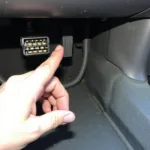The P0136 OBD2 code is a common issue for Nissan 200SX owners. This code indicates a problem with the oxygen sensor circuit, specifically Bank 1, Sensor 2. But what does that mean, and how can you fix it? This comprehensive guide will delve into the P0136 code, its causes, symptoms, diagnostic procedures, and potential solutions, empowering you to take control of your Nissan 200SX’s performance.
Before diving into the specifics of the P0136 code, it’s crucial to understand the role of oxygen sensors in your vehicle’s emissions system.
Oxygen sensors, also known as O2 sensors, are vital components of your Nissan 200SX’s engine management system. They measure the amount of oxygen in the exhaust stream, providing crucial data to the Engine Control Unit (ECU). The ECU uses this information to adjust the air-fuel mixture, optimizing engine performance and minimizing harmful emissions.
The “Bank 1, Sensor 2” designation in the P0136 code refers to the sensor’s location. “Bank 1” indicates the engine bank containing cylinder #1. “Sensor 2” signifies the downstream oxygen sensor, positioned after the catalytic converter. This sensor monitors the catalytic converter’s efficiency in reducing harmful emissions.
What Does the P0136 Code Mean?
The P0136 code specifically signals that the ECU has detected a problem with the electrical circuit of the downstream oxygen sensor (Bank 1, Sensor 2). This issue could stem from various factors, including wiring problems, a faulty sensor, or issues with the sensor’s heater circuit.
Common Symptoms of a P0136 Code
While the check engine light illuminating on your dashboard is the most apparent sign of a P0136 code, you might also experience other symptoms, including:
- Decreased Fuel Economy: A malfunctioning oxygen sensor can disrupt the air-fuel mixture, leading to reduced fuel efficiency.
- Sluggish Acceleration: An imbalanced air-fuel ratio can negatively impact your engine’s performance, resulting in slower acceleration.
- Rough Engine Idle: The engine might idle rough or erratically due to the incorrect air-fuel mixture.
- Increased Emissions: A faulty oxygen sensor can hinder the catalytic converter’s effectiveness, leading to higher emissions.
What Causes a P0136 Code?
Several factors can contribute to a P0136 code in your Nissan 200SX:
- Faulty Oxygen Sensor: The downstream oxygen sensor itself might be worn out or damaged, causing inaccurate readings.
- Wiring Issues: Damaged, corroded, or loose wiring within the sensor circuit can disrupt signal transmission.
- Exhaust Leaks: Leaks in the exhaust manifold, pipes, or other components upstream of the sensor can introduce excess oxygen, confusing the sensor.
- Faulty Catalytic Converter: While less common, a malfunctioning catalytic converter can trigger a P0136 code if it affects the oxygen levels in the exhaust stream.
- ECU Malfunction: Although rare, a problem with the ECU itself could lead to inaccurate sensor readings.
How to Diagnose a P0136 Code
Accurately diagnosing the root cause of the P0136 code is crucial for effective repair. Here’s a step-by-step guide:
- Read the Code: Use an OBD2 scanner to retrieve the stored trouble codes.
- Inspect the Wiring: Visually examine the wiring harness connected to the downstream oxygen sensor for any signs of damage, corrosion, or loose connections.
- Check for Exhaust Leaks: Inspect the exhaust system for any visible holes, cracks, or loose components that could cause leaks.
- Test the Sensor: Use a multimeter to test the oxygen sensor’s voltage and resistance. Compare your readings to the manufacturer’s specifications.
- Inspect the Catalytic Converter: Assess the catalytic converter for any signs of damage or blockage.
“A thorough diagnosis is essential to avoid unnecessary part replacements. Start by checking the simplest possibilities, such as wiring issues, before moving on to more complex components like the oxygen sensor itself,” advises Jake Carter, a certified automotive technician with over 15 years of experience.
How to Fix a P0136 Code
The repair solution for a P0136 code depends on the underlying cause identified during the diagnostic process. Here are the most common fixes:
- Replace the Oxygen Sensor: If the downstream oxygen sensor is faulty, replacement is usually the most effective solution.
- Repair Wiring Issues: Repair or replace any damaged, corroded, or loose wiring within the sensor circuit.
- Fix Exhaust Leaks: Address any exhaust leaks by tightening connections, replacing gaskets, or repairing damaged components.
- Replace the Catalytic Converter: If the catalytic converter is malfunctioning, replacement is typically necessary.
- Consult a Mechanic: If you’re uncomfortable performing the repairs yourself or the issue persists, consult a qualified mechanic for further assistance.
Conclusion
The P0136 OBD2 code, indicating a problem with your Nissan 200SX’s downstream oxygen sensor circuit, can impact your vehicle’s performance and emissions. By understanding the code’s meaning, recognizing its symptoms, and following the diagnostic and repair steps outlined in this guide, you can resolve the issue effectively, ensuring your Nissan 200SX runs smoothly and efficiently.
Remember, regular maintenance and timely repairs are crucial for keeping your vehicle in optimal condition. If you encounter any issues or have questions, don’t hesitate to seek assistance from a qualified mechanic.

